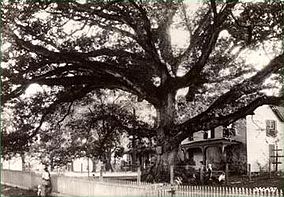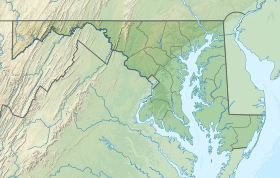Wye Oak
| Wye Oak State Park | |
|---|---|
 Wye Oak, September 1929 | |
| Location | Wye Mills, Maryland, U.S. |
| Coordinates | 38°56′21″N 76°04′51″W / 38.93917°N 76.08083°W |
| Area | 29 acres (12 ha)[2] |
| Elevation | 43 ft (13 m) |
| Designation | Maryland state park |
| Established | 1939 |
| Administrator | Maryland Department of Natural Resources |
| Website | Wye Oak State Park |

The Wye Oak was the largest
The Wye Oak was believed to be over 460 years old at the time of its destruction during a severe thunderstorm on June 6, 2002. It measured 31 feet 10 inches (970 cm) in circumference of the trunk at breast height, 96 feet (29 m) high, with a crown spread of 119 feet (36 m).[4] It is believed that the acorn that became the oak germinated around 1540. Its largest limb, estimated to weigh 35 short tons (31.5 tonnes) and six feet (1.8 meters) thick, fell earlier, on June 10, 1984.[5] The Wye Oak was still bearing a maturing crop of acorns when it was toppled.[6]
The Wye Oak drew public attention in 1909, when
The tree fell during a heavy thunderstorm with high winds on the night of June 6, 2002. The tree's exceptionally long life has been attributed to the efforts of park managers, who applied preventive measures such as fertilizer and insecticide as well as extensive pruning, cabling, and bracing of the branches.[6]
State park
The Maryland General Assembly purchased the tree and established Wye Oak State Park in 1939. At its creation, the park was a little over an acre in size, according to Wye Oak: The History of a Great Tree by Dickson J. Preston:
[A]t 2:45 p.m. on September 20, 1939, just before the options were due to expire, the deeds transferring title to the State of Maryland were recorded at the Talbot County Courthouse in Easton. The Kinnamon and Straughn lots were identical in size: each had a frontage of 74½ feet and extended back from the road for a distance of 19 perches (a perch equals a rod, or 16½ feet, so that their depth was 313.5 feet [95.6 m]). The park thus created was about an acre and a half [sic; this actually works out to just over an acre] in size – the smallest in the state and perhaps in the nation, though not nearly as small as most people thought.[10]
The park's current 29 acres (12 ha) protect the nearby stream valley from development. The site of the Wye Oak remains largely untouched, and the descriptive plaque placed there in 1921 remains at the site.[11] The park also includes a one-room brick schoolhouse dating from colonial times; it is the second-oldest schoolhouse in Talbot County.[3][12]
Cloning
Dr. Frank Gouin, Professor Emeritus of
Artworks
Upon its falling, immediate efforts were made to salvage and preserve the tree's remains.
See also
- List of individual trees
- State Trees of the United States
- Wye Oak (band)
References
- ^ "Wye Oak State Park". Protected Planet. IUCN. Retrieved May 1, 2018.
- ^ "DNR Lands Acreage Report" (PDF). Maryland Department of Natural Resources. 2022. p. 9. Retrieved March 10, 2023.
- ^ a b c "Wye Oak State Park". Maryland Department of Natural Resources. Retrieved November 26, 2013.
- ^ "State Symbols: Maryland State Tree - White Oak (Wye Oak)". Maryland Manual On-Line. Maryland State Archives. Retrieved July 28, 2015.
- ^ Preston, Dickson J. (November 1984). "Our Largest Oak Looses a Limb". American Forests. 90 (11): 42, 43, 62, and 63.
- ^ a b "Chapter 5: Correction of Hazardous Defects in Trees" (PDF). Urban Tree Risk Management: A Community Guide to Program Design and Implementation. U.S. Forest Service. pp. 150–152. Retrieved July 28, 2015.
- ^ "The Quiet Giant: The Wye Oak". Maryland Department of Natural Resources. Retrieved February 2, 2016.
- ^ "Untitled". Packages. Vol. 22, no. 12. Milwaukee, Wisc.: Packaging Publishing Co. December 1919. p. 21. Retrieved September 11, 2015.
- ^ Arthur S. Brisbane (June 21, 1984). "MD's Wye Oak is still massive after 35 ton loss". The Washington Post.
- ISBN 0-87033-180-9.
- ^ "The Wye Oak". Historical Marker Database. Retrieved November 6, 2017.
- ^ "Wye Oak House". Historical Marker Database. Retrieved November 6, 2017.
- ^ "An American Champion: Maryland's Wye Oak". Special Collections. National Agricultural Library. June 12, 2002. Archived from the original on June 12, 2002.
- ^ "Wye Oak * National Champion White Oak". Historical Marker Database. Retrieved November 6, 2017.
- ^ "Mobilizing to Preserve the Wye Oak". Maryland Department of Natural Resources. Archived from the original on February 2, 2010.
- ^ McLaughlin, M. Stark (Fall 2002). "The Wye Oak". Wye Oak State Park. Maryland Department of Natural Resources. Retrieved February 4, 2020.
- ^ de Vise, Daniel (November 19, 2004). "Rebirth of the noble Wye Oak: Centuries-old tree, felled by storm, transformed into stately desk for governor". The Washington Post. p. B01. Retrieved November 26, 2013.
- ^ "The Wye Oak Gallery". Maryland Department of Natural Resources. Archived from the original on January 27, 2008. Retrieved July 28, 2015.
External links
- Wye Oak State Park Maryland Department of Natural Resources

